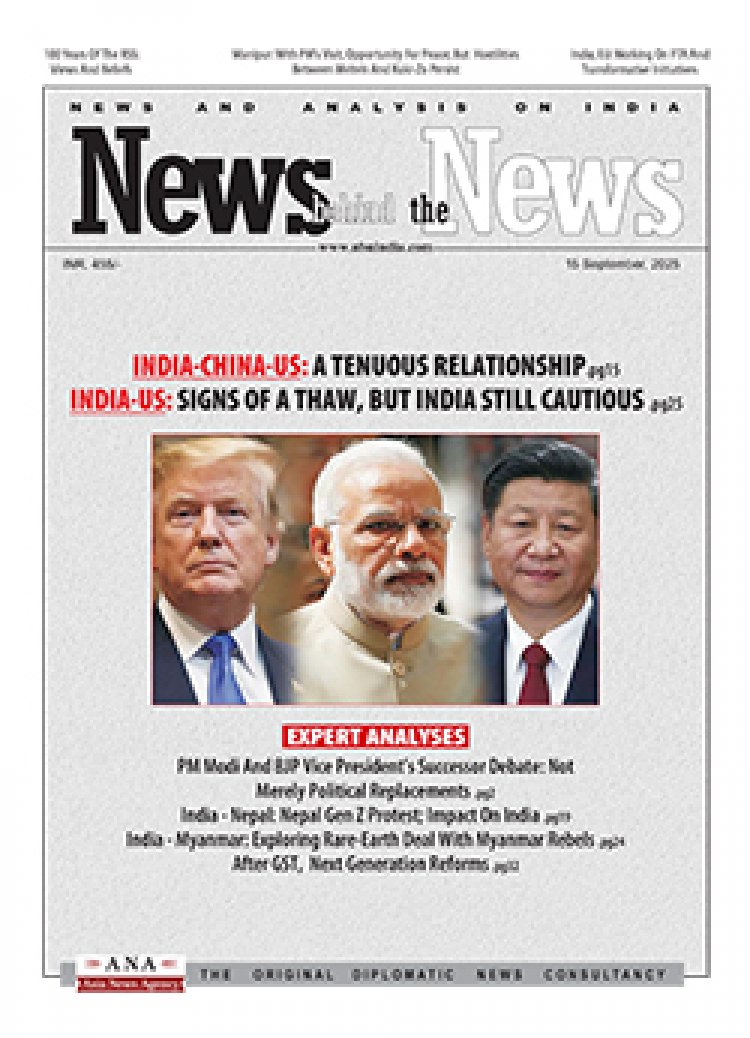India - Canada: PM Modi Meets Canadian PM Carney
Asia News Agency

Prime Minister Narendra Modi, Tuesday met Canadian Prime Minister Mark Carney on the sidelines of the G7 Summit in Kananaskis. The two leaders discussed ways to add momentum to the India-Canada friendship, highlighting the strong bond between the two nations based on shared values of democracy, freedom, and the rule of law.
‘India and Canada are connected by a strong belief in democracy, freedom and the rule of law. PM Carney and I look forward to working closely to add momentum to the India-Canada friendship,’ Modi said.
Carney described his bilateral meeting with Modi ‘as foundational, as a necessary first step, an exchange of views, frank, open exchange of views around law enforcement, transnational repression, an agreement to provide the necessary foundations to begin to rebuild a relationship based on mutual respect, sovereignty and trust.’
The leaders identified several areas with immense potential for cooperation, including trade, clean energy, space, critical minerals, and fertilisers. The meeting reflects the growing importance of India-Canada relations, with both nations committed to strengthening their partnership.
The reset begins
The reset in relations has thus begun, according to most analysts. The outcomes speak for themselves.
Restore high commissioners: Two years after a major rupture in ties, India and Canada have agreed to restore high commissioners in Delhi and Ottawa and discuss restarting talks for a trade agreement, visa services and other dialogue mechanisms.
‘The Prime Ministers agreed to take calibrated steps to restore stability to this very important relationship. The first of these steps agreed upon was to restore high commissioners to each other’s capitals at an early date,’
Working level mechanisms related to trade etc: Foreign Secretary Vikram Misri announced after the meeting, adding that ‘senior and working level mechanisms in a host of areas related to trade, people to people contact, and connectivity’ had also been resumed.
Other collaborations: In addition, the two Prime Ministers discussed collaborations in ‘clean energy, digital transformation, artificial intelligence, LNG, food security, critical minerals, higher education, mobility, and supply chain resilience’, a statement by the Ministry of External Affairs said.
Khalistani activist Nijjar’s case not discussed directly: Significantly neither side directly referred to the case of Khalistani activist Hardeep Singh Nijjar gunned down in Canada two years ago, which led to a rift in bilateral ties after the former Trudeau government accused the Indian government of orchestrating the killing, and India accused Canada of failing to protect Indian diplomats from Khalistani threats.
Carney refers to Transnational Repression’ (TNR): However, Carney referred to the problem of ‘Transnational Repression’ (TNR), both ahead of talks with Modi, and in the readout of the meeting. PM Carney, the readout said, raised priorities on the G7 agenda, including transnational crime and repression, security, and the rules-based order’ .
Incidentally, in a joint statement on TNR issued separately, G7 leaders condemned all violence and harassment against ‘dissidents, journalists, human rights defenders, religious minorities, and those identified as part of diaspora communities’ by other countries.
A purposeful reboot
India and Canada, writes Ajay Bisaria (served as India’s high commissioner to Canada) “quietly signalled a thaw in their 21-month-long diplomatic freeze, turning the margins of a multilateral gathering into a moment of bilateral reset.”
The meeting between the two leaders, he says, was among most significant developments, “which helped unfreeze bilateral ties. The two nations, embroiled in mutual recriminations since Sept 2023 – including diplomatic expulsions and collapsed political dialogue – used the summit for a purposeful reboot…..”
Not a spontaneous reset: Readouts “spoke of calibrated steps return of high commissioners to New Delhi and Ottawa, resumption of stalled ministerial dialogue, and renewed cooperation in clean energy, food security, AI, and critical minerals. Most crucially, negotiations on the paused Early Progress Trade Agreement (EPTA) will resume – potentially setting the stage for a full Comprehensive Economic Partnership Agreement (CEPA).”
This wasn’t a spontaneous reset, writes Bisaria. "It was months in the making. Quiet diplomacy between the foreign ministries and backchannel track-2 efforts paved the way. For New Delhi, the political de-escalation created strategic space to recalibrate. For Ottawa, arrival of a new PM with no baggage from Khalistan activists allowed a policy rethink.”
Beyond diplomatic damage control: This reset “aspires to go beyond diplomatic damage control. Both countries are now building institutional shock absorbers – starting with clearer law enforcement protocols insulated from political heat. Modi, after all, had signed a strategic partnership deal with former Canadian PM Stephen Harper a decade ago. The task now is to fulfil that framework’s promise – this time through calibrated, interest-based escalation driven by the ‘living bridges’ between peoples and businesses.”
The right moment: Even as the G7 in Kananaskis showcased a world teetering between crisis and recalibration, Bisaria concludes “for India and Canada, it offered just the right moment to pivot away from months of recrimination and toward renewed pragmatism. Modi’s strategic message to Trump, and his meeting with Carney, reveal a govt that has internalised the logic of a multipolar world: engage where interests align, push back where sovereignty is challenged, and anchor diplomacy in national interest rather than global validation. For New Delhi and Ottawa, the task ahead is not just to restore normalcy – but to reimagine partnership. A reset, if done right, may become a model for how democracies with differences can find common cause again.”
The G7’s unravelling and India-Canada reset
Harsh V Pant (vice president, Observer Research Foundation (ORF), New Delhi) and Vivek Mishra (deputy director, Strategic Studies Programme, fellow, China Studies, ORF)
Amid this backdrop of uncertainty and disunity, Prime Minister (PM) Narendra Modi’s visit to Canada marked a surprising but welcome turn in bilateral relations. This thaw comes after a prolonged period of diplomatic strain under former Canadian PM Justin Trudeau’s tenure. The renewal of ties signals more than a reset — it hints at a strategic recalibration of the G7 itself in response to the shifting global economic landscape, especially the rising influence of the Global South. Canada’s India outreach takes on deeper significance as both countries re-evaluate their foreign policy alignments. For Canada, caught between an unpredictable US and an increasingly untrustworthy China, engagement with India offers a stabilising alternative. In this regard, the India-Canada Joint Statement’s emphasis on “shared democratic values, respect for the rule of law, and commitment to the principles of sovereignty and territorial integrity,” along with mutual sensitivities marks a significant and welcome departure from the tensions of recent years.
The decision to reinstate respective high commissioners, resume senior ministerial and working-level engagements, and identify areas of cooperation that could eventually lead to a Comprehensive Economic Partnership Agreement (CEPA) augurs well for the bilateral relations and demonstrates strategic maturity and intent in Canada to insulate the relationship from domestic political turbulence.
This diplomatic reset marks a key follow through from PM Mark Carney’s campaign promise to relook at India-Canada ties, signalling a possible pragmatic approach towards India despite opposition from certain quarters in Canada. Canada’s long-term geo-economic strategy is evolving, and engagement with India is likely to become a key component of it both bilaterally and as an actor in the Indo-Pacific.
The shifting character of the G7 was perhaps most visible at this year’s summit. Its inability to maintain a unified position on Ukraine, evidenced by the retraction of a previously agreed statement, revealed the continued centrality of US support — not just in diplomacy, but also in financial and security commitments. Yet, the presence of India, Brazil, Mexico, and South Africa served as a subtle but powerful signal that the G7 is being compelled to engage with the Global South in new and meaningful ways.
The G7, once a club of like-minded wealthy democracies, is at a crossroads. A dual dynamic of Western recalibration and Southern assertion is defining its current evolution. While internal cohesion among Western nations remains under pressure, a simultaneous embrace of emerging powers is becoming necessary. The road ahead will likely require balancing continued engagement with a less predictable US and deeper integration with economies that are assuming a growing role in global political and economic affairs.
The group’s future relevance will depend not only on its ability to maintain unity within but also on its willingness to share space and shape the agenda with rising powers like India. The India-Canada thaw, in this context, is more than a bilateral correction as it signals that rebalancing of Western global economies may not remain just a choice but a necessity.
















